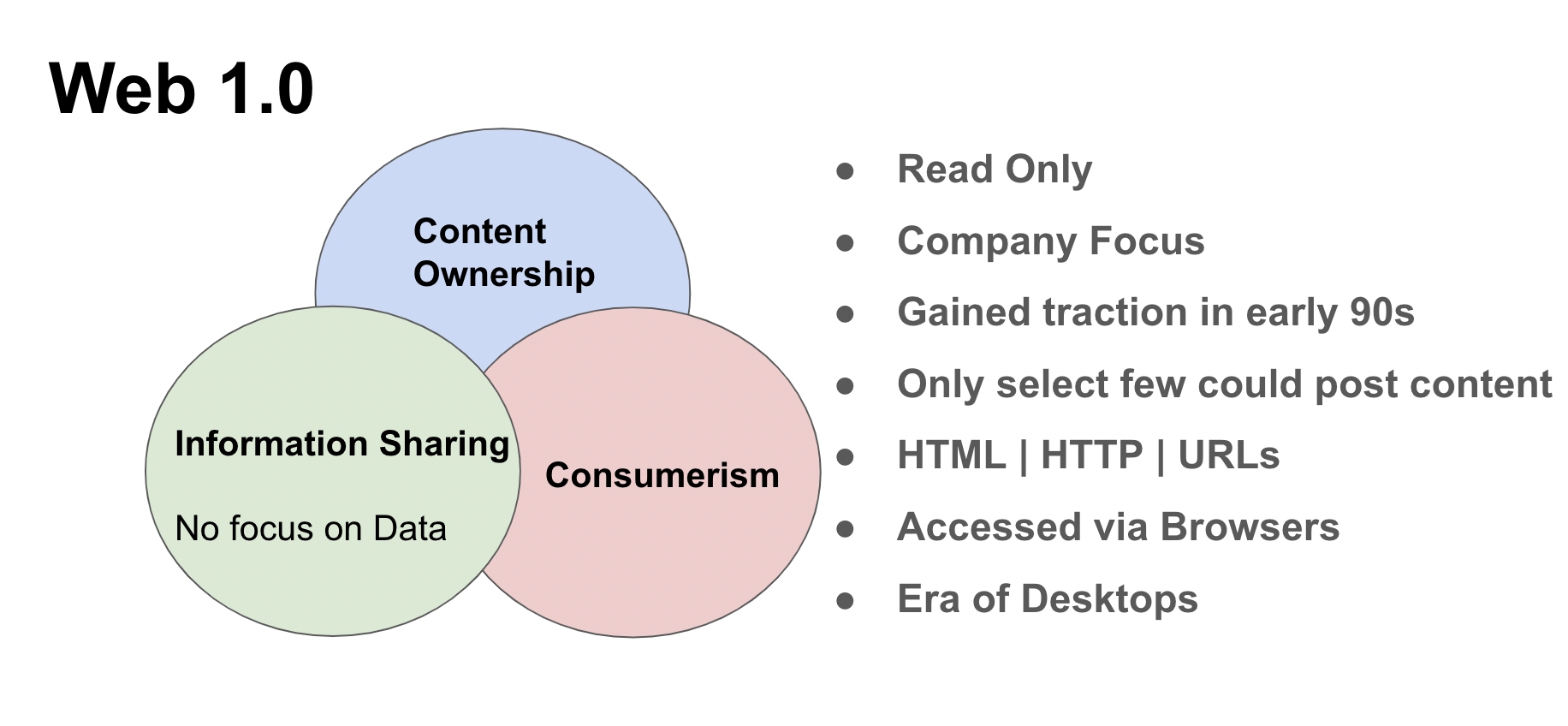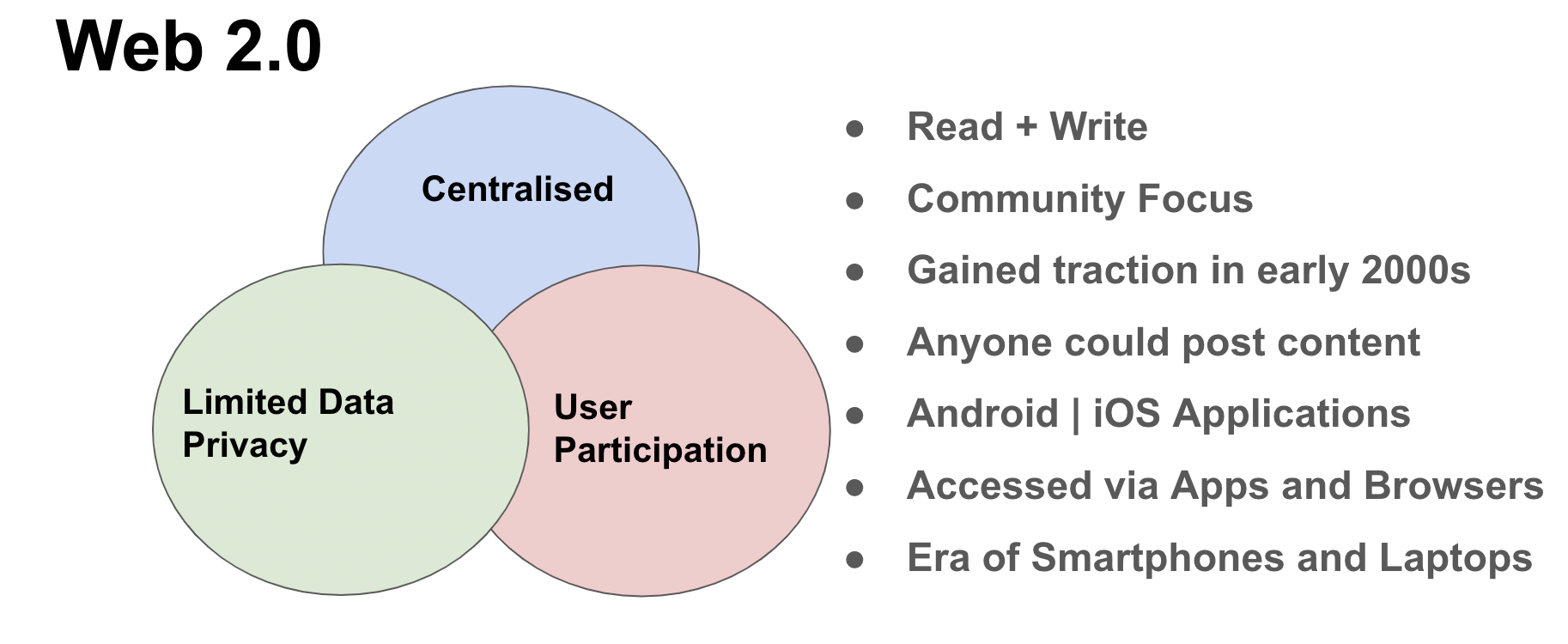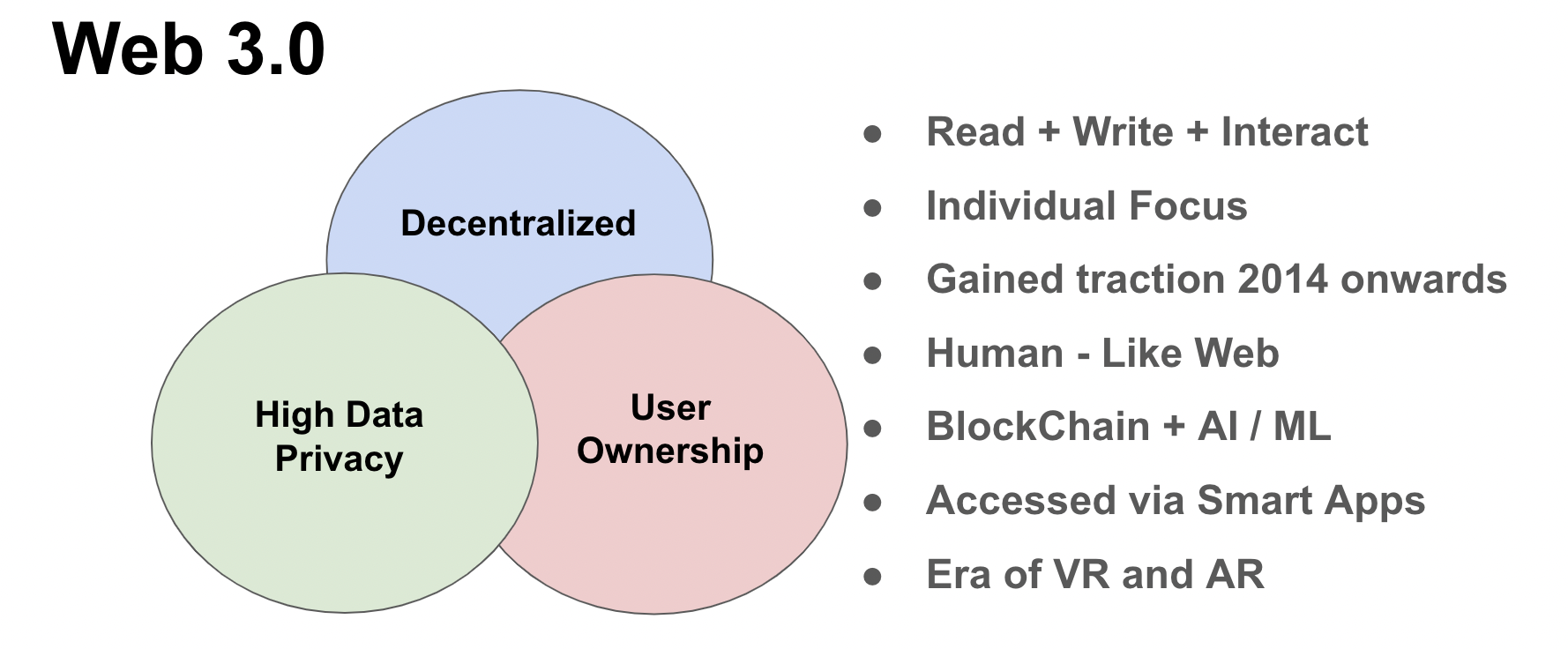Understanding Web 3.0 – Kickstart with the Basics of the Next-Gen Web
Introduction
Web 3.0 is the next generation – introducing a new phase of the World Wide Web. Sounds exciting? Let’s deep dive into it and understand what it is?
In this blog, we will learn about what the Web is fundamental. Understanding the evolution of the Web over time. And Deep dive into the core principles and vision that drive Web 3.0 – further understanding it with the help of an example.
The Web – High-level view
Evolution is the key!
Like humans have evolved over the ages, along with other natural species,
So has the backbone of today’s world – the Web.
-
What is the Web?
The web is a collection of HTML pages stored on a server that can be retrieved as per the user’s need using a Web Browser.
WWW – World Wide Web – has evolved over the generations.
From Web 1.0 in the early 90s to Web 2.0 gaining traction in the 2000s, the future beholds Web 3.0, which has concepts of Decentralization, AI-ML, and Blockchain at its core.

But the question arises –
-
What is Web 3.0?
-
What is the need for it?
-
Why should I invest time in understanding this term?
-
And how is it different from Web 2.0?
To begin with – we will have to touch upon the basics of what is the Web – how it has changed over time – and what has triggered this evolution (survival of the fittest ) in the first place?

-
Web 1.0 – was based on basic technologies like HTML, HTTP, and URLs which helped real-time retrieval of news articles, emails, and basic content in the early 90s. Only specific individuals could upload information on the internet.
-
Offerings: Web 1.0 – was fulfilling the need for consuming the content and information available on the internet,
-
Shortcomings: There was less scope for user interaction – in terms of expressing views on the quality of the article, contributing to the content, and sharing it with peers or friends.
-
The Need: So, Web 2.0 gradually developed.
-

-
Web 2.0 – gained popularity in the 2000s and helped Internet users contribute to content creation, upload articles, comment on specific videos, products, posts, etc.
-
Offerings: The Like, Subscribe, and Share options on Youtube, writing blogs on websites like WordPress, Selling your products on Amazon and Marketing via social media channels like Instagram and Facebook, and voicing your opinion via Twitter are all examples of what Web 2.0 offers.
-
Shortcomings: But in Web 2.0 – the control of the internet remains with a handful of larger companies like Facebook, Amazon, Apple, Netflix, and Google (FAANG) – as it is popularly known. Users have less control over their data points, and sometimes privacy breaches also happen.
-
Hence The Need for Web 3.0 has arisen – which is yet to take a formal form.
-

-
Web 3.0 – will make the internet more decentralized, globalized, and permissionless. The control of the users’ data will remain with themselves; any piece of information can be stored on multiple machines and shared anywhere across the globe – and it is free of many regulations and restrictions.
-
Offerings: A more open and fair internet with a vision to enable democratized data, ownership privacy, and smart application designs.
-
Shortcomings: Lack of Control, Regulations, Governance, Security, and Legal compliance.
-
Now that we have developed a generic understanding of the Web and have an overview of the growth of the Web over time. Let us, deep dive into the world of Web 3.0.
Web 3.0: Deep Dive
Web 3.0 is a big concept – which engulfs the principles of decentralized, trustless, permissionless open – source blockchain architecture.
It started gaining traction in 2014 – It is still a work in progress.
One by One – we will understand the core principles, technologies, examples, and possibilities of Web 3.0:-
The Example
A Centralised Social Media versus a Decentralised Social Media Network
| Facebook
(Centralised Social Media Network) |
Steemit
(Decentralised Social Media Network) |
| Owned by Meta | Owned by registered Users |
| Read-Write | Read-Write-Interact |
| Shared Content | Consolidated Content |
| Data ownership with Meta | Data ownership with Users |
| Targeted Marketing | Behavioural Marketing |
| Incentives in terms of User reactions | Incentives in terms of Network Tokens |
The Principles
-
Decentralised – Ownership of Digital Identity and Individual Data Profile
You have control over your own digital identity, data points and data profile. You are empowered to make your own decisions with regards to your time, money and resources – as there are less chances of individuals being the victims of targeted marketing.
-
Ubiquity – Open Source and Accessible to all.
The data, information, posts, content that you share are accessible from anywhere and via any device to anyone. The Internet of Things will take it to a very advanced level.
-
Trustless – No trusted third party is required to authorize a transaction or interaction
For example – if you have to buy bitcoin, you can directly buy from the bitcoin owner without involving an exchange. No one can disrupt the transaction.
-
Permissionless – No permission is required from a third party like regulatory bodies or government before making an actual transaction or interaction
-
Connectivity-based Consolidation – smart and intelligent consolidation of information across all sources to render the best results based on the user profile and requirements
-
Network Incentivised transactions – All the content that is shared on the Web 3.0-based applications can get upvotes and downvotes based on the user reactions. By any such transaction, the network tokens like bitcoins are generated – promoting the network incentivized transactions.
The Technology
-
Semantic Web – A web that deciphers content in a human-like manner leveraging the AI – rather than only keyword searches, numbers, and digital signals. This results in a more meaningful User Experience and enhances User Interactions.
-
Blockchain – The blockchain technology that leverages the principles of Encryption and Distributed Computing to democratize data and enable Individual ownership over the content and digital assets.
-
Artificial Intelligence – The core enabler of the Semantic web – with predictive techniques like Machine learning and NLP. It produces a holistic user experience and more relevant search results.
-
Smart Contracts – This enables the users to carry out trustless and permissionless transactions and interactions with the help of a private key. (More information on this is in the introduction to the Blockchain blog).
-
Edge Computing – The need for highly compute effective systems increases with AI – ML, Blockchain, and Smart Contract being the fundamental operating blocks of Web 3.0.
-
3D Graphics – Three-dimensional graphics like a 360-degree tour of the Eiffel tower or a virtual – real-world experience in a Computer Car-racing game – add to the additional enriched experiences of Web 3.0.
The Possibilities
Web 3.0 is still in its nascent stage. The core vision of Web 3.0 is a Decentralised Web – to enable Individual User empowerment, fair ownership of user data and digital assets, and securing User privacy while enabling a meaningful user experience. It also envisions a Human-like web – where interactions are more behavioural rather than digital signal based. The development of Intelligent smart applications lies at the crux of it.
Conclusion
Since all of the above ensure Web 3.0 is a user-empowered web world, the future is in your hands.
This can be achieved by developing a strong understanding of Web 3.0. Further, taking responsibility for designing Smart Intelligent Web 3.0 applications that comply and adhere to fundamental principles of Ethics, Governance, and Legal Compliance.
Let us contribute to building together a responsible community-oriented Web 3.0 – keeping the betterment of the Human Race at the centre of its evolution.









